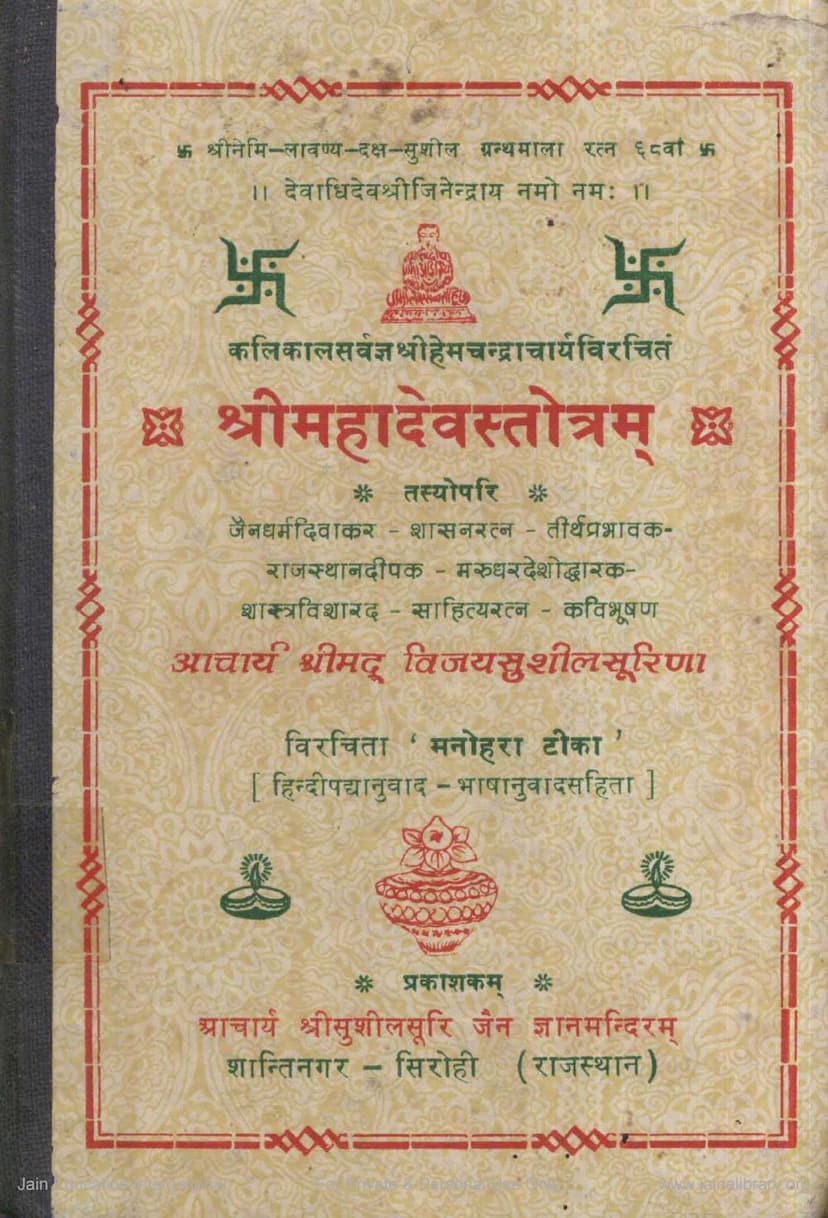Mahadev Stotram
Added to library: September 2, 2025

Summary
Here is a comprehensive summary of the Jain text "Mahadev Stotram," based on the provided pages:
Overview:
The book "Mahadev Stotram" is a revered Jain devotional hymn attributed to the great scholar and Jain saint, Acharya Hemchandracharya. The text presented here is an edition published by Sushilsuri Jain Gyanmandiram Sirohi. This particular edition features a commentary called "Manohara Teeka" (meaning "beautiful commentary") written by Acharya Shrimad Vijay Sushil Suri. The edition also includes a Hindi translation in verse and prose, making the ancient Sanskrit text accessible to a wider audience.
Key Themes and Content:
-
The True "Mahadev": The central theme of the "Mahadev Stotram" is to redefine and establish the true "Mahadev" (Great God) within the Jain philosophical framework. Acharya Hemchandracharya, through his 44 verses, logically argues and establishes that the Jinas (Jineshwar Bhagwan), the liberated souls who have conquered their passions (rag-dwesh), are the actual Mahadevas. The stotram refutes the notion of other deities being Mahadev, asserting that the qualities attributed to a "Mahadev" are found exclusively in the Jinas.
-
Jain Concept of God: The "Prakathan" (Foreword) section extensively discusses the Jain concept of God, which fundamentally differs from prevalent Hindu notions.
- Rejection of a Single, Creator God: Jainism rejects the idea of a single, creator-destroyer God who is eternally aloof from the world. It also disavows the concept of divine avatars.
- Infinite Gods (Liberated Souls): In Jainism, God is not a singular entity but infinite liberated souls (Siddhas). Every soul has the potential to achieve liberation and become a God (Paramatma, Mahadev) by eradicating karmic bonds and realizing its inherent perfect qualities.
- Qualities of the Jain God: The Jain "God" is identified with Arhants and Siddhas – souls who have conquered anger, pride, deceit, greed, attachment, aversion, and all other passions and karmas. These beings are omniscient, omnipotent (in their own realm), eternally blissful, and possess infinite knowledge, vision, bliss, and power. They do not interfere in the workings of the universe but guide souls towards liberation.
-
Structure and Argumentation of the Stotram:
- Defining Mahadev through Qualities: The stotram begins by defining "Mahadev" based on essential qualities such as being serene, fear-dispelling, auspicious, praiseworthy, and possessing great knowledge, power, and compassion.
- Refutation of Other Deities: A significant portion of the stotram (verses 20-33) meticulously dissects the traditional attributes of Brahma, Vishnu, and Mahesh (Shiva) as described in Puranic literature. Acharya Hemchandracharya systematically demonstrates that these deities, as described with their specific birthplaces, parents, vehicles, weapons, and forms, are inherently contradictory to the concept of a single, unified, and perfect divine being. The verses highlight the logical inconsistencies in attributing multiple forms, origins, and attributes to a singular entity.
- The Triad (Brahma, Vishnu, Mahesh) as Jain Principles: In verses 33-34, the stotram reinterprets the Brahma-Vishnu-Mahesh triad. It explains that these names metaphorically represent the core principles of Jainism:
- Vishnu represents Knowledge (Jnana), particularly Keval Jnana (omniscience).
- Brahma represents Right Conduct/Character (Charitra).
- Shiva (Mahesh) represents Right Faith/Vision (Sammyaktva/Darshan). The Jinas embody all these perfect qualities, making them the true "Mahadev."
- Eight Qualities of the Jinas: The stotram further elucidates that the Jinas possess eight symbolic qualities (Gunas) often associated with other deities, like Earth, Water, Fire, Air, Sacrifice, Sky, Moon, and Sun, but reinterprets them as spiritual attributes of the Jinas.
- The "A-RA-HA" Mantra: The latter part of the stotram (verses 39-43) provides a detailed etymological and philosophical explanation of the "A-RA-HA" mantra, showing how each syllable ("A" for Vishnu, "RA" for Brahma, "HA" for Mahesh) symbolizes the supreme qualities of the Jina. The concluding "anuswar" (bindu) represents the liberated state (Siddhashila).
- The Ultimate Vow: The concluding verse emphasizes that true devotion should be directed towards the possessor of these qualities, regardless of the name or tradition. The ultimate goal is to transcend the cycle of birth and death by shedding passions, and the Jinas are the perfect exemplars of this path.
-
The Commentary ("Manohara Teeka"):
- Written by Acharya Shrimad Vijay Sushil Suri, the commentary is praised for its simplicity, clarity, and flow.
- It follows a structured approach for each verse: Introduction (Avataranika), Original Verse (Mul Padya), Word-for-word grammatical analysis (Anvay), Sanskrit commentary (Manohara Teeka), Hindi Verse Translation (Padyanuvad), Word Meanings (Shabdarth), and finally, Verse Meaning (Shlokarth) and its deeper implication (Bhavarth).
- The commentary aims to make the profound philosophical arguments of Hemchandracharya easily understandable.
-
Dedication and Contributors:
- The book is dedicated to the late Acharya Shrimad Vijay Lavanyasurishwarji Maharaj Saheb by his disciple, Acharya Shrimad Vijay Sushil Suri, in remembrance of his immense blessings.
- The publication was made possible through the generous financial support of Sanghvi Shri Devichandji Shrichandji of Takhatgarh.
- Various scholars and individuals are acknowledged for their contributions, including the commentator Acharya Shrimad Vijay Sushil Suri, the editor Muni Shrimad Vinod Vijayji Ganivarya, the foreword writer Dr. Chetanprakash Patni, and others involved in the printing and typesetting.
-
Additional Content:
- The book includes sections like "Arhant Pad ki Bhavana" and "Siddh Pad ki Bhavana," which elaborate on the significance and qualities of Arhants and Siddhas, reinforcing the Jain concept of divine beings.
- It also contains "Hit Shiksha" (Beneficial Teachings), "Nav Prashna" (Nine Questions for self-reflection), "Hitopadesh" (Beneficial Advice), and "Meri Bhavna" (My Feelings/Aspirations), offering spiritual guidance and philosophical insights.
Significance of the Text:
The "Mahadev Stotram" is a landmark text in Jain literature for its theological clarity and argumentative prowess. It demonstrates the Jain perspective on divinity by presenting a rational and ethical framework that elevates the liberated soul (Jina) to the status of the ultimate "Mahadev." The "Manohara Teeka" further enhances its accessibility, allowing readers to grasp the philosophical depth and devotional essence of this important work.